|
Made for the Western and Brazilian Telegraph Company by Hooper's Telegraph Works.
Co-directors of William Hooper put forward a scheme to set up the Great Western Telegraph Company to lay a cable from England to the USA and on to Bermuda. They had been attracted by the profits being made by the Anglo American Telegraph Company. The Telegraph Construction and Maintenance Company, which had a substantial holding of shares in Anglo American, offered them its South American concessions on the condition they dropped the transatlantic plan, which they did.
These concessions had been granted by the Brazilian Emperor to Sir Charles Tilston Bright who in turn sold them to Telcon. The Great Western Telegraph Company was wound up and the Western and Brazilian Telegraph Company (W&B) was set up in its place.
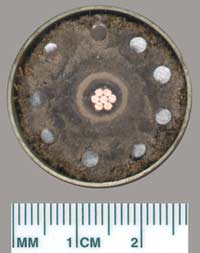 |
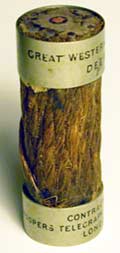 |
Hooper's Atlantic cable for the Great Western Telegraph Company, used instead on the
Para-Rio de Janeiro route.
See the middle sample
in the cable case above. |
The cable already manufactured by Hooper's Telegraph Works for the Atlantic was used on the east coast of South America between Para and Rio de Janeiro. CS Hooper laid the cables during 1873 from Para-Maranham-Ceara-Pernambuco-Bahia-Rio de Janeiro.
[Note that Maranham is now Maranhão]
The catalogue entry at the Hunterian Museum for the largest of the cable sections in the sample case shown above reads in part:
WESTN. & BRAZILN. Co. CABLE B. HOOPER'S LONDON. (engraved on the brass bands holding the ends of the section of cable together).
The specimen is in a plush lined box marked on the purple silk in the lid "SPECIMENS OF WESTERN AND BRAZILIAN TELEGRAPH Co.'s CABLES: RIO DE JANEIRO TO PARA MANUFACTURED AND SUBMERGED BY HOOPER'S TELEGRAPH WORKS, LIMITED, LONDON. 1873."
This section is from a shore-end cable and is comprised of a inner core of seven strands of copper surrounded by an insulating layer of what appears to be paper and gutta-percha similar to Hooper's patent core of 1868. The overall construction is also similar to the Atlantic cable of 1866 The core is reinforced with ten strands of 6mm hot dipped galvanised iron wire wrapped in a vegetable fibre to form the cable. In this specimen the ends have been dipped in pitch obscuring the vegetable fibre. It is interesting to note that David Thomson King (Kelvin's favorite nephew) reported that the Para to Cayene section of this cable was attacked by fish and was damaged to the core no fewer than six times whilst the cable was being laid in 1874. The cable laying ship the "Gomos" was stranded on the Bar at the mouth of the Rio Grande on May 26 that year. There was no loss of life and David swam ashore after two days on the wreck. A new length of cable was hastily made and on November 25, 1874 David, in charge of the electrical department, set sail on the cable laying ship "La Plata" with the new cable. He was drowned when the ship foundered in the Bay of Biscay a few days later. His place was later taken by Lord Kelvin's nephew William Bottomley junior (1849-1912) and the cable was completed in 1876.
This article on the manufacture of the cable was published in Harper's Weekly, 19 April 1873.
Ocean Telegraph Cables
The process of manufacturing a submarine telegraph cable is a work requiring the most skillful and delicate manipulation, and the employment of complicated and ingenious machinery. The slightest carelessness may result in a flaw or weakness which may render the cable useless after a few months’ service, and render necessary the expensive and often tedious process of fishing it up for repairs.
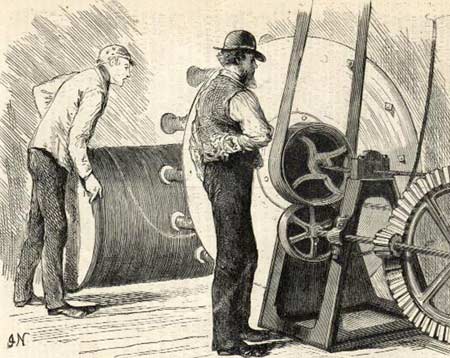
Covering the Electric Core with Jute |
The engravings on this page are from sketches made at one of the most extensive manufactories of submarine cables in England, known as “Hooper’s Telegraph Works,” where cables nearly 5000 miles in length are now in process of manufacture for the Great Western Telegraph Company. These cable, originally intended to be laid across the Atlantic, will be submerged along the coast of South America, in connection with a line to be laid from Lisbon to the Brazils. The “core,” or conducting portion of these cables, consists of a strand of seven copper wires covered with India rubber under “Hooper’s” patent process, and further served with a coating of jute yarn, while the sheathing, or outer protection, is, for the “deep-sea” cable, formed of homogeneous iron wires covered with Manilla yarn. The “intermediate” and “shore-end” cables are formed of the core coated with jute, as already described, and covered with iron wire, of sufficient size and weight to prevent the possibility of accident from ships’ anchors, or otherwise. The third engraving represents the covering of the “intermediate” cable with jute, and a preservative compound of tar, etc. The fourth engraving shows the method of coiling the completed cable in the tank. This is a process requiring extreme care, to prevent kinking and consequent flaws in the core.
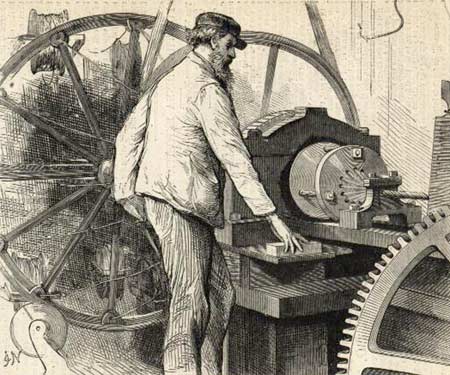
Covering the Core with Wire |
For the purpose of laying these cables a special steam-ship is to be built for the company, and fitted up with the most approved appliances for laying and picking up submarine cables [CS Hooper]. This vessel, which is the first one ever constructed especially for this service, will, in addition to the ordinary propelling screw, be fitted with a transverse screw, or propeller, designed to give extreme facility in manoeuvring, especially in stormy weather, when the motion of the ship renders the cable liable to breakage, owing to the heavy strain in paying out. New machinery has also been devised, which it is thought will greatly facilitate this part of the work, and so regulate the running out of the cable as to make the strain even and uniform in the most boisterous weather. Scientific experts who have watched the manufacture of this cable state that it is the best and strongest ever made for submarine service.
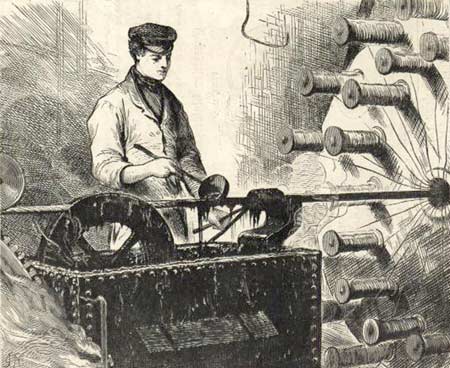
Covering the Cable with Jute and Tar |
Many of our readers will remember the interest, mingled with incredulity, with which the manufacture of the first Atlantic cable was watched, with what anxiety the whole world waited for the first message flashed over the wires along the bed of the ocean, and with what a grand outburst of rejoicing the success of the undertaking was hailed in Europe and America It was the talk and wonder of the civilized world. Less enthusiasm greeted the laying of the second cable, and even the magnificent achievement of finding, picking up, and repairing the broken cable was regarded as almost a matter of course. And now ocean telegraphs have become so common as to excite little more curiosity than the building of a land line. So soon do wonders cease to be wonders. Who can tell how soon we shall see the problem of aerial navigation solved, and the daily arrival and departure of atmospheric ships excite no more remark than the ascension of an anchored balloon in Central Park?
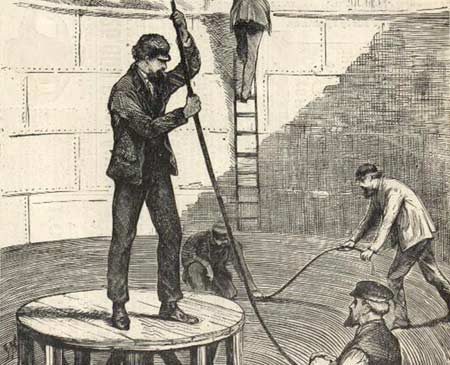
Coiling Down the Cable in the Tanks |
The impracticable Ruskin is perhaps the only man in the world who regards the telegraph as an invention of the powers of darkness. He would do away with it altogether, as well as with railroads and every other means of rapid communication and travel. The world at large believes in progress, and that every thing which tends to make nations better acquainted, to blend their interests, and to improve their condition, will hasten the time when war shall be no more, but peace shall reign throughout the prosperous and happy world.
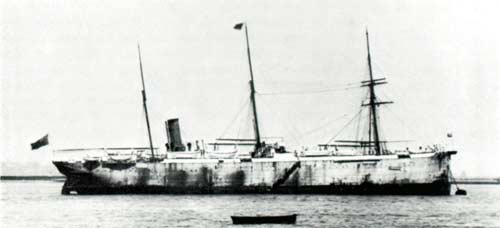
CS Hooper, later CS Silvertown |
See also this article which includes detailed information on the 1874 cable: Para - Demerara, British Guiana - Cayenne, French Guiana, also laid by CS Hooper. |

